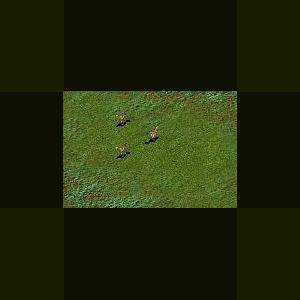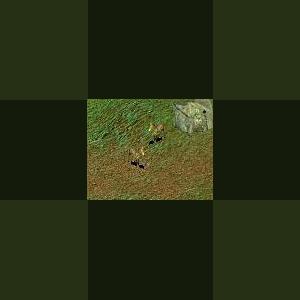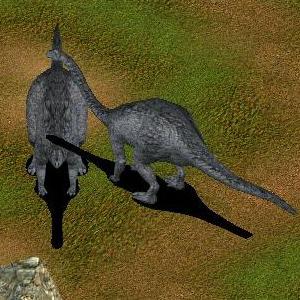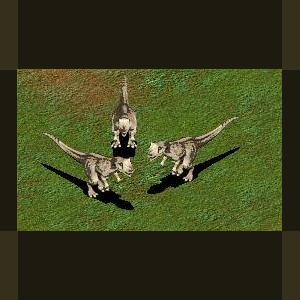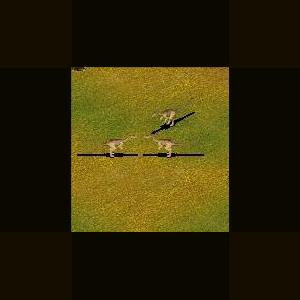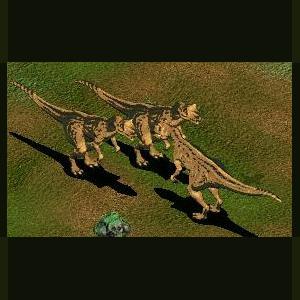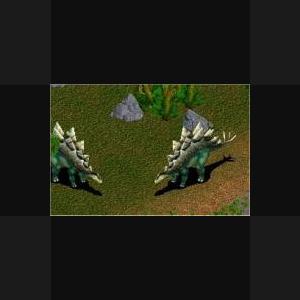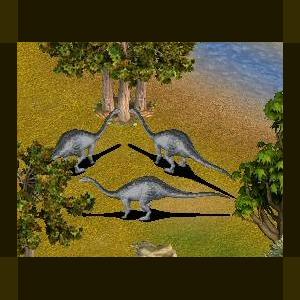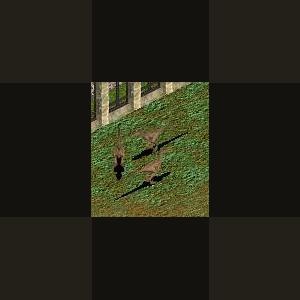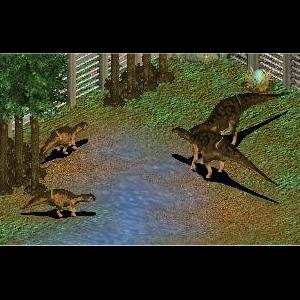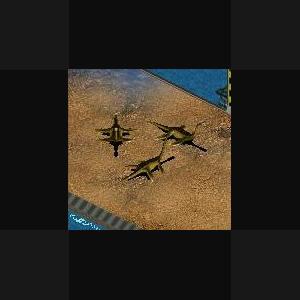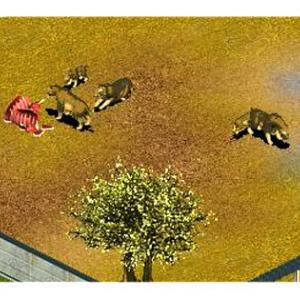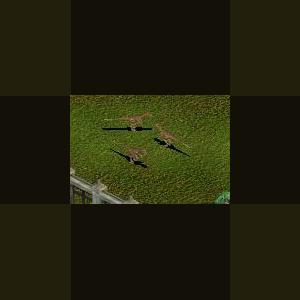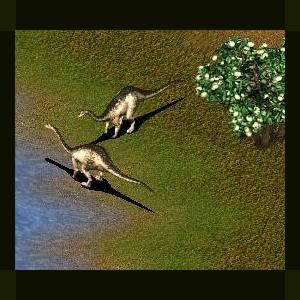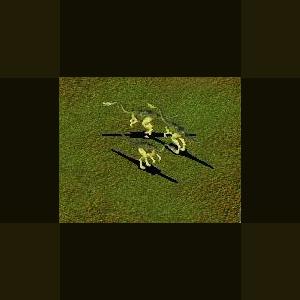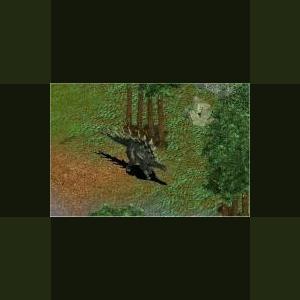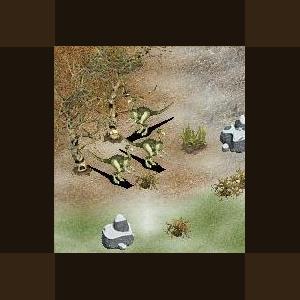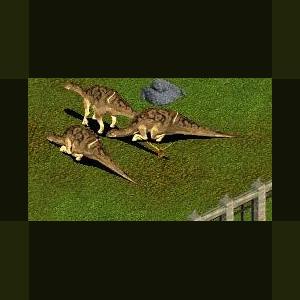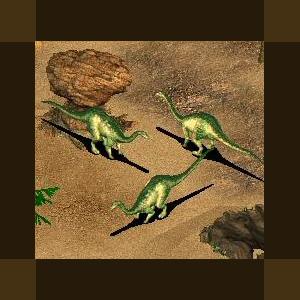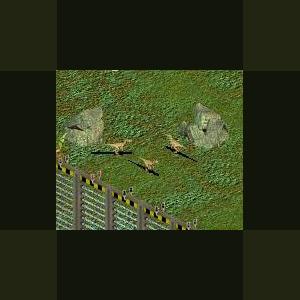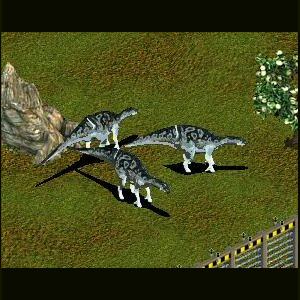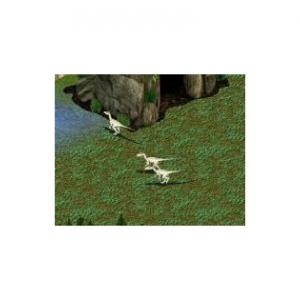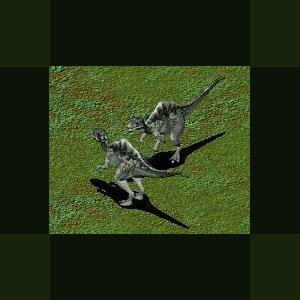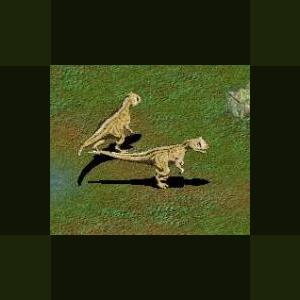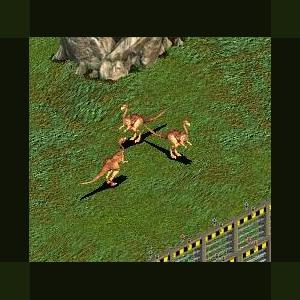Dinosaurs
Creatures from another age
241 files
-
Microraptor by Moondawg
By Guest
Microraptor had two sets of wings, on both its fore- and hind legs. The long feathers on the legs of Microraptor were true flight feathers as seen in modern birds, with asymmetrical vanes on the arm, leg, and tail feathers. As in bird wings, Microraptor had both primary (anchored to the hand) and secondary (anchored to the arm) flight feathers. This standard wing pattern was mirrored on the hind legs, with flight feathers anchored to the upper foot bones as well as the upper and lower leg. It had been proposed by Chinese scientists that the animal glided, and probably lived in trees, pointing to the fact that wings anchored to the feet of Microraptor would have hindered their ability to run on the ground, and suggest that all primitive dromaeosaurids may have been arboreal.
Sankar Chatterjee determined in 2005 that, in order for the creature to glide or fly, the wings must have been split-level (like a biplane) and not overlayed (like a dragonfly), and that the latter posture would have been anatomically impossible. Using this biplane model, Chatterjee was able to calculate possible methods of gliding, and determined that Microraptor most likely employed a phugoid style of gliding--launching itself from a perch, the animal would have swooped downward in a deep 'U' shaped curve and then lifted again to land on another tree. The feathers not directly employed in the biplane wing structure, like those on the tibia and the tail, could have been used to control drag and alter the flight path, trajectory, etc. The orientation of the hind wings would also have helped the animal control its gliding flight. Chatterjee also used computer algorithms that test animal flight capacity to test whether or not Microraptor was capable of true, powered flight, in addition to passive gliding. The resulting data showed that Microraptor did have the requirements to sustain level powered flight, so it is theoretically possible that the animal flew on occasion in addition to gliding.
Some paleontologists have suggested that feathered dinosaurs used their wings to parachute from trees, possibly in order to attack or ambush prey on the ground, as a precursor to gliding or true flight. In their 2007 study, Chatterjee and Templin tested this hypothesis as well, and found that the combined wing surface of Microraptor was too narrow to successfully parachute to the ground without injury from any significant height. However, the authors did leave open the possibility that Microraptor could have parachuted short distances, as between closely spaced tree branches.
Chatterjee and Templin also ruled out the possibility of a ground-based takeoff. Microraptor lacked the necessary adaptations in its shoulder joint to lift its front wings high enough vertically to generate lift from the ground, and the authors argued that a ground-based takeoff would have damaged flight feathers on the feet. This leaves only the possibility of launching from an elevated perch, and the authors noted that even modern birds do not need to use excess power when launching from trees, but use the downward-swooping technique they found in Microraptor.
The unique wing arrangement found in Microraptor raised the question of its importance to the origin of flight in modern birds--did avian flight go through a four-winged stage, or were four-winged gliders like Microraptor an evolutionary side-branch that did not leave descendants? As early as 1915, some scientists had argued that the evolution of bird flight may have gone through a four-winged (or tetrapteryx) stage. Chatterjee and Templin did not take a strong stance on this possibility, noting that both a conventional interpretation and a tetrapteryx stage are equally possible. However, based on the presence of unusually long leg feathers in various feathered dinosaurs, Archaeopteryx, and some modern birds such as raptors, as well as the discovery of Pedopenna (another dinosaur with long primary feathers on its feet), the authors argued that the current body of evidence, both from morphology and phylogeny, suggests that bird flight did shift at some point from shared limb dominance to front-limb dominance, and that all modern birds may have evolved from four-winged ancestors, or at least ancestors with unusually long leg feathers relative to the modern configuration.
The naming of Microraptor is controversial, because of the unusual circumstances of its first description. The first specimen to be described was part of a chimeric specimen , a patchwork of unrelated feathered dinosaur species assembled from multiple specimens in China and smuggled to the USA for sale. After the forgery was revealed by Xu Xing of Beijing's Institute of Vertebrate Paleontology and Paleoanthropology, Storrs L. Olson, curator of birds in the National Museum of Natural History of the Smithsonian Institution, published a description of the tail in an obscure journal, giving it the name Archaeoraptor liaoningensis in an attempt to remove the name from the paleornithological record by assigning it to the part least likely to be a bird. However, Xu had discovered the remainder of the specimen from which the tail had been taken and published a description of it later that year, giving it the name Microraptor zhaoianus.
Since the two names designate the same individual as the type specimen, Microraptor zhaoianus is a junior objective synonym of Archaeoraptor liaoningensis and the latter, if valid, has priority. So, according to some interpretations of the International Code of Zoological Nomenclature, the valid name for this dinosaur probably is Archaeoraptor liaoningensis Olson 2000. However, there is some doubt whether Olson in fact succeeded in meeting all the formal requirements for establishing a new taxon. Most paleontologists are unwilling to use the name Archaeoraptor regardless of the precise legal status of the name. This is firstly because that name is strongly associated with the fraud and the National Geographic scandal and secondly because they view Olson's use of the name as attempted nomenclatural sabotage and do not want to support it. The name Microraptor zhaoianus Xu et al., 2000 has therefore almost attained universal currency.
293 downloads
0 comments
Updated
-
Merychippus by Moondawg
By Guest
Merychippus is a proto-horse that lived between 17 and 11 million years ago in the Miocene period.
It had three toes on each foot and is the first horse known to have grazed. Its name means "ruminant horse", but it is not now thought that Merychippus ruminated.
Merychippus lived in herds. It was about twelve hands (48 inches) tall; at the time it was the tallest equine to have existed. The muzzle was longer, the jaw deeper, and the eyes wider apart than any other horse-like animal to date. The brain was also much larger, making it smarter and more agile. Merychippus was the first equine to have the distinctive head of today's horses. The foot was fully supported by ligaments, and the middle toe developed into a hoof, which did not have a pad on the bottom. In some Merychippus species, the side toes were larger, whereas in others, they had become smaller and only touched the ground when running. Its teeth were like those of Parahippus (the extra crest that was variable in Miohippus was permanent in Merychippus, and the other teeth were beginning to form a series of tall crests with higher crowns).
194 downloads
0 comments
Updated
-
Melanorosaurus by Moondawg
By Guest
Melanorosaurus
Melanorosaurus, "Black Mountain Lizard", from the (Greek melano "black", "mountain" + saurus"lizard", was a 12 meter long sauropod dinosaur that lived in the Late Triassic period. A herbivore from South Africa, it had a great body and sturdy limbs, suggesting it moved about on all fours. Limb bones were massive and weighty, like sauropod limb bones. But, like most sauropods vertebrae, its spinal bones had hollows that helped reduce weight. Unfortunately, a skull has not been found to date.
The type specimen was described in 1924, having been collected from the Upper Triassic Elliot Formation on the north slope of the Thaba 'Nyama (Black Mountain) in Transkei, South Africa. It wasn't until 2007 when the first complete skull of Melanorosaurus was described.[1] Two species are known: M. readi, the type species, and M. thabanensis.
Melanorosaurus was once classified as a prosauropod, but is now recognized as one of the earliest known sauropods. Once thought to be an ancestral basal assemblage to the sauropods, differences in e.g. the design of their ankle bones point out that these are sister groups. Basal sauropods such as Melanorosaurus, Anchisaurus and Antetonitrus are intermediate between these groups.
Melanorosaurus had a skull which measured approximately 250 mm. The snout was somewhat pointed, and the skull was somewhat triangular when seen from above or below. The premaxilla had four teeth on each side, a characteristic of primitive sauropodomorphs. The maxilla had 19 teeth on each side of the jaw.
Melanorosaurus was around 12 meters long.
158 downloads
0 comments
Updated
-
Megaraptor by Moondawg
By Guest
Megaraptor ("giant thief") was once thought to be the largest dromaeosaur ever found, but is now known to be a carnosaur related to Allosaurus.
It lived in Late Cretaceous times in the Patagonian region of Argentina. It was a contemporary of Giganotosaurus, one of the largest carnivorous dinosaurs of all time.
Megaraptor was initially described as a giant dromaeosaur, known primarily from a single claw (about 1ft long) that resembled the sickle-shaped foot claw of dromaeosaurids. The discovery of a complete front limb, however, showed that this giant claw actually came from the first finger of the hand. The hands were unusually elongated, bore sickle-shaped claws even more recurved than those of spinosaurids.The hand is quite distinct from other basal tetanurans, so it is not clear whether Megaraptor is an allosaurid, a carcharodontosaurid, a spinosauroid, or something else entirely.
It should be noted that, when first discovered and prior to publication, the spinosaurid Baryonyx was also reported to be a dromaeosaurid, again based on a large hand claw.
Megaraptor's size is debated. However, most experts have come to agree that Megaraptor is approximately 8 meters (26 feet) in length and 3 meters (10 feet) in height.
179 downloads
0 comments
Updated
-
Megapnosaurus by Moondawg
By Guest
Megapnosaurus
Megapnosaurus (meaning "big dead lizard", from Greek = "big", = "not breathing", "dead", = "lizard") was a dinosaur of the theropod family Coelophysidae, formerly called Syntarsus (named by Raath, 1969), living during the Early Jurassic. It was renamed by American entomologist Dr. Michael Ivie (Montana State University of Bozeman), Polish Australian Dr. Adam Slipinski, and Polish Dr. Piotr Wegrzynowicz (Muzeum Ewolucji Instytutu Zoologii PAN of Warsaw), the scientists who discovered that the genus name Syntarsus was already taken by a colydiine beetle described in 1869.
Some paleontologists did not like the name Megapnosaurus. This was partially because taxonomists are generally expected to allow original authors of a name to correct any mistakes that may have arisen from their work. Raath was aware of the synonymy between the dinosaur Syntarsus and beetle Syntarsus, but the group who published Megapnosaurus had been led to believe Raath was deceased and proceeded accordingly. Megapnosaurus remains a valid name, though whether it can be treated as synonymous with Coelophysis is an open question.
It is almost identical to Coelophysis, and Yates (2005) suggested that Megapnosaurus was possibly synonymous with Coelophysis. In 2004, Raath co-authored two papers in which he argued that "Syntarsus" (Raath continued to use the old, invalid, name) was a junior synonym of Coelophysis.
Megapnosaurus measured up to 3 meters (10 ft) long from nose to tail and weighed about 32 kilograms (70 lb). The bones of 30 Megapnosaurus individuals were found together in a fossil bed in Zimbabwe, so paleontologists think it may have hunted in packs. The various fossils attributed to Megapnosaurus have been dated over a relatively large time span - the Hettangian, Sinemurian, and Pliensbachian stages of the Early Jurassic - meaning the fossils represent either a highly successful genus or a few closely related animals all currently assigned to Megapnosaurus.
Megapnosaurus is a good example of how dinosaurs spread across the globe from their ancestral habitats (which was possibly South America). This small predator had the same basic features found in early dinosaurs, and its appearance in both Africa and the southwestern U.S. indicates that it migrated through the continents, which at the time were joined together as Pangaea. There is species-level differentiation between the African and U.S. specimens, again supporting the migration and adaptation theories.
The African species (M. rhodesiensis) is known from almost 30 specimens. The North American species (M. kayentakatae) had small crests and may show an evolutionary step toward later and larger coelophysoids, such as the more derived Dilophosaurus. Both possess a weak joint between the premaxillary and the maxillary bones, creating a hooked premaxillary jaw. This led to the early hypothesis that dinosaurs such as these were scavengers, as the front teeth and bone structure were thought to be too weak to take down and hold struggling prey.
130 downloads
0 comments
Updated
-
Megalosaurus by Moondawg
By Guest
Megalosaurus (meaning "Great Lizard", from Greek,megalo- meaning 'big', 'tall' or 'great' and sauros meaning 'lizard') is a genus of large meat-eating theropod dinosaurs of the Middle Jurassic Period (Bathonian) o
Megalosaurus was the first dinosaur to be described. Part of a bone was recovered from a limestone quarry at Cornwell near Chipping Norton, Oxfordshire, England in 1676. The fragment was sent to Robert Plot, Professor of Chemistry at the University of Oxford and first curator of the Ashmolean Museum, who published a description in his Natural History of Oxfordshire in 1677. He correctly identified the bone as the lower extremity of the femur of a large animal and he recognized that it was too large to belong to any known species; he considered it to be the thigh bone of a giant. The bone has since been lost but the illustration is detailed enough to identify it clearly as the femur of a Megalosaurus.
The Cornwell bone was described again by Richard Brookes in 1763. He named it Scrotum humanum, while describing its similar appearance to a pair of human testicles. The label was not considered to be a "name" for the animal in question at the time, and was not used in subsequent literature. Technically, the name was published after the advent of binomial nomenclature, and although this name theoretically had priority over Megalosaurus, the rules of the ICZN state that if a name falls into disuse for 50 years after publication, it is no longer in competition for priority. Therefore, the name Scrotum humanum is a nomen oblitum, or "forgotten name".
More discoveries were made, starting in 1815, again at the Stonesfield quarry. They were acquired by William Buckland, Professor of Geology at the University of Oxford and dean of Christ Church. He did not know to what animal the bones belonged but, in 1818, after the Napoleonic Wars, the French comparative anatomist Georges Cuvier visited Buckland in Oxford and realised that the bones belonged to a giant lizard-like creature. Buckland then published descriptions of the bones in Transactions of the Geological Society, in 1824 (Physician James Parkinson had described them in an article in 1822).
226 downloads
0 comments
Updated
-
Mbielu-Mbielu-Mbielu by Ghirin
By Guest
Mbielu-mbielu-mbielu by Ghirin
The name Mbielu-mbielu-mbielu means "the animal with planks growing out of its back."
This cryptid is from the Likouala swamp region of the Republic of Congo. The exact nature of Mbielu-mbielu-mbielu is unknown. Some think that it is similar to a stegosaur while others think that the cryptid is snake-like.
References:
www.wikipedia.org
http://www.cryptozoology.net/english/afric...u/overview.html
*Inspired by Professor Paul's Nature Encyclopedia*
176 downloads
0 comments
Updated
-
Massospondylus by Moondawg
By Guest
Massospondylus
Massospondylus (Greek 'elongated vertebra'), formerly known as Aristosaurus, was an Early Jurassic Period prosauropod, although, if Aetonyx is the same as Massospondylus, it lived from the Late Triassic as well. It was probably a plant eater (herbivore), although it is speculated that the prosauropods may have been omnivorous. This dinosaur was named by Sir Richard Owen in 1854, from remains found in South Africa. It is thus one of the first dinosaurs to be named.
Massospondylus (pronounced,(masson, "longer") and (spondylos, "vertebra") is a genus of prosauropod dinosaur from the early Jurassic Period (Hettangian to Pliensbachian ages, ca. 200–183 million years ago). It was described by Sir Richard Owen in 1854 from remains found in South Africa, and is thus one of the first dinosaurs to have been named. Fossils have since been found at other locations in South Africa, Lesotho, and Zimbabwe. Further material from Arizona's Kayenta Formation, India, and Argentina has been assigned to this genus, but may not belong to Massospondylus.
The type, and only universally recognized, species, is M. carinatus, although six other species have been named during the past 150 years. Prosauropod systematics have undergone numerous revisions during the last several years, and many scientists disagree where exactly Massospondylus lies on the dinosaur evolutionary tree. The family name Massospondylidae was once coined for the genus, but because knowledge of prosauropod relationships is in a state of flux, it is unclear which other dinosaurs—if any—belong in a natural grouping of massospondylids; several 2007 papers support the family's validity.
Although Massospondylus was long depicted as quadrupedal, a 2007 study found it to be bipedal. It was probably a plant eater (herbivore), although it is speculated that the prosauropods may have been omnivorous. This animal, 4–6 meters (13–20 feet) long, had a long neck and tail, with a small head and slender body. On each of its forefeet, it bore a sharp thumb claw that was used in defense or feeding. Recent studies indicate Massospondylus grew steadily throughout its lifespan, possessed air sacs similar to those of birds, and may have cared for its young.
Massospondylus was a mid-sized prosauropod that was around 4 meters (13 ft) in length and weighed approximately 135 kilograms (300 lb), although a few sources have estimated its length at up to 6 meters (20 ft). Although long assumed to have been quadrupedal, a 2007 anatomical study of the forelimbs has questioned this, arguing that their range of motion precluded effective habitual quadrupedal gait. The study also ruled out the possibility of "knuckle-walking" and other forms of locomotion that would avoid the issue of the limited ability of Massospondylus to pronate its hands. Although its mass suggests a quadrupedal nature, it would have been restricted to its hind legs for locomotion.
Massospondylus was a typical prosauropod in most other respects. It possessed a slender body and long neck, with around nine long cervical (neck) vertebrae, 13 dorsal (back) vertebrae, three sacral (hip) vertebrae, and at least 40 caudal (tail) vertebrae. The pubis faced forward, as with most saurischians. It had a slighter build than that of Plateosaurus, an otherwise similar prosauropod dinosaur. A recent discovery shows that Massospondylus possessed well-developed clavicles, joined in a furcula-like arrangement, suggesting both that it had immobile shoulder blades and that clavicles were not rudimentary and nonfunctional in those dinosaurs that did not have true furculae. This discovery also indicates that the furcula of birds is derived from clavicles.
Like Plateosaurus, it had five digits on each foot, with a large thumb claw used for feeding or defense against predators. The fourth and fifth digits of the forepaws were tiny, giving the forepaws a lopsided look. The 2007 study indicated that Massospondylus held its manus (hands) in a semi-supinated ("prayer-like") orientation, with the palmar surfaces facing one another; the wrist was never found rotated in articulated (still-connected) fossil specimens.
The small head of Massospondylus was approximately half the length of the femur. Numerous openings, or fenestrae, in the skull reduced its weight and provided space for muscle attachment and sensory organs. These fenestrae were present in pairs, one on each side of the skull. At the front of the skull were two large, elliptical nares. The orbits were proportionally larger in Massospondylus than in related genera such as Plateosaurus. The antorbital fenestrae, smaller than those seen in Plateosaurus, were situated between the eyes and the nose. At the rear of the skull were two more pairs of temporal fenestrae: the lateral temporal fenestrae immediately behind the eye sockets and the supratemporal fenestrae on top of the skull. Small fenestrae also penetrated each mandible. The shape of the skull is traditionally restored as wider and shorter than that of Plateosaurus, but this appearance may be due just to differential crushing experienced by the various specimens.Some features of the skull are variable between individuals; for example, the thickness of the upper border of the orbit and the height of the posterior maxilla. These differences may be due to sexual dimorphism or individual variation.
As with other prosauropods, it has been proposed that Massospondylus had cheeks. This theory was proposed because there are a few large holes for blood vessels on the surfaces of the jaw bones, unlike the numerous small holes present on the jaws of cheekless reptiles. The cheeks would have prevented food from spilling out when Massospondylus ate. Crompton and Attridge (1986) described skulls of Massospondylus as possessing pronounced overbites and suggested the presence of a horny beak on the tip of the lower jaw to make up the difference in length and account for tooth wear on the teeth at the tip of the snout. However, this was later shown to be a misinterpretation based on crushing in a top–bottom plane. Skulls not crushed in this orientation do not show an overbite. There also seems to be some variation of tooth morphology based on the position of teeth in the jaw. The heterodonty present in Massospondylus is greater than that present in Plateosaurus, although unsurprisingly not as pronounced as the specialization of teeth in Heterodontosaurus. Teeth closer to the front of the snout had round cross-sections and tapered to points, unlike the back teeth, which were spatulate and had oval cross-sections.
Many species have been named, although most are no longer considered valid. M. carinatus, named by Richard Owen, is the type species. Other named species include: M. browni (Seeley, 1895), M. harriesi (Broom 1911), M. hislopi (Lydekker, 1890), M. huenei (Cooper, 1981), M. rawesi (Lydekker, 1890), and M. schwarzi (Haughton, 1924).
M. browni, M. harriesi, and M. schwarzi were all found in the Upper Elliot Formation of Cape Province, South Africa. All three are based on fragmentary material, and were regarded as indeterminate in the most recent review. M. browni is based on two cervical, two back, and three caudal vertebrae and miscellaneous hind limb elements. M. harriesi is known from a forelimb.M. schwarzi is known from an incomplete hind limb and sacrum. M. hislopi and M. rawesi were named from fossils found in India. M. hislopi is based on vertebrae from the Upper Triassic Maleri Formation of Andhra Pradesh, whereas M. rawesi is based on a tooth from the Upper Cretaceous Takli Formation of Maharashtra. M. hislopi was tentatively retained as an indeterminate sauropodomorph in the latest review,but M. rawesi may be a theropod or nondinosaur. M. huenei is a combination derived by Cooper for Lufengosaurus huenei, as he considered Lufengosaurus and Massospondylus to be synonyms. This synonymy is no longer accepted.
Several dinosaurs are often considered synonymous with Massospondylus. These include Aristosaurus, Dromicosaurus, Gryponyx, Hortalotarsus, Leptospondylus, and Pachyspondylus, which are dubious names of little scientific value. Hortalotarsus skirtopodus was named by Harry Seeley in 1894. The fossils consist of partial leg bones. The following year, Richard Owen named a few fossil vertebrae Leptospondylus capensis and Pachyspondylus orpenii. These fragmentary fossils were later destroyed in World War II. Aristosaurus erectus was named by E.C.N. van Hoepen in 1920 based on a nearly complete skeleton. Hoepen also named Dromicosaurus gracilis, which consisted of a partial skeleton. Gryponyx taylori was named by Sidney H. Haughton in 1924. It consists of hip bones. All of the above fossils come from the Hettangian or Sinemurian faunal stages of South Africa, where Massospondylus has been found. Under the rules of zoological nomenclature, these names are junior synonyms. They were named after Massospondylus was described in a scientific paper; the name Massospondylus thus takes priority.
Massospondylus is a prosauropod, a grouping of early saurischian dinosaurs that lived during the Triassic and Jurassic, but which had died out by the end of the Jurassic. Other members of the group include Plateosaurus, Yunnanosaurus, and Riojasaurus. Basal sauropodomorph systematics continue to undergo revision, and many genera once considered classic prosauropods have recently been removed from the group in phylogenetic nomenclature, on the grounds that their inclusion would not constitute a clade (a natural grouping containing all descendants of a single common ancestor). Exactly which animals constitute a monophyletic (natural grouping) of prosauropods is unclear. Yates and Kitching (2003) published a clade consisting of Riojasaurus, Plateosaurus, Coloradisaurus, Massospondylus, and Lufengosaurus. Galton and Upchurch (2004) included Ammosaurus, Anchisaurus, Azendohsaurus, Camelotia, Coloradisaurus, Euskelosaurus, Jingshanosaurus, Lessemsaurus, Lufengosaurus, Massospondylus, Melanorosaurus, Mussaurus, Plateosaurus, Riojasaurus, Ruehleia, Saturnalia, Sellosaurus, Thecodontosaurus, Yimenosaurus and Yunnanosaurus in a monophyletic Prosauropoda. Wilson (2005) considered Massospondylus, Jingshanosaurus, Plateosaurus, and Lufengosaurus a natural group, with Blikanasaurus and Antetonitrus possible sauropods. Bonnan and Yates (2007) considered Camelotia, Blikanasaurus and Melanorosaurus possible sauropods. Yates (2007) placed Antetonitrus, Melanorosaurus, and Blikanasaurus as basal sauropods and declined to use the term Prosauropoda, as he considered it synonymous with Plateosauridae. However, he did not rule out the possibility that a small group of prosauropods consisting of Plateosaurus, Riojasaurus, Massospondylus and their closest kin were monophyletic.
Massospondylus is the type genus of the proposed family Massospondylidae, to which it gives its name. The Massospondylidae family may also include Yunnanosaurus, although Lu et al. (2007) placed Yunnanosaurus in its own family. Yates (2007) considered Massospondylus, Coloradisaurus, and Lufengosaurus massospondylids, with Yunnanosaurus in Anchisauria. Smith and Pol (2007) also found a Massospondylidae in their phylogenetic analysis, including Massospondylus, Coloradisaurus, and Lufengosaurus, as well as their new genus, Glacialisaurus.Adeopapposaurus, based on the fossils once thought to belong to a South American form of Massospondylus, was also classified as a massospondylid.
The faunas and floras of the Early Jurassic were similar worldwide, with conifers adapted for hot weather becoming the common plants, and prosauropods and basal theropods the main constituents of a worldwide dinosaur fauna. The environment of early Jurassic southern Africa has been described as a desert. African Massospondylus was a contemporary of early crocodylomorphs; tritylodontid and trithelodontid therapsids; morganucodontid mammals; and dinosaurs including the small theropod Megapnosaurus rhodesiensis; a species of Melanorosaurus (M. thabanensis); and several genera of early ornithischians, such as Lesothosaurus and the heterodontosaurids Abrictosaurus, Heterodontosaurus, and Lycorhinus.
It is not clear which carnivores may have preyed on Massospondylus. Most of the theropods which have been discovered in rocks of Early Jurassic age in southern Africa, such as Megapnosaurus, were smaller than mid-sized prosauropods like Massospondylus. These smaller predators have been postulated as using fast slashing attacks to wear down prosauropods, which could have defended themselves with their large hand and foot claws. The 6-meter-(20 ft-) long carnivorous theropod Dracovenator lived during the same period (Hettangian to Sinemurian stages) as Massospondylus and has also been found in the Elliot Formation of South Africa.
As with all dinosaurs, much of the biology of Massospondylus, including its behavior, coloration, and physiology, remains unknown. However, recent studies have allowed for informed speculation on subjects such as growth patterns, diet,posture, reproduction, and respiration.
A 2007 study suggested that Massospondylus may have used its short arms in defense from predators ("defensive swats"), in intraspecies combat, or in feeding, although its arms were too short to reach its mouth. Scientists speculate that Massospondylus could have used its large pollex (thumb) claw in combat, to strip plant material from trees,digging, or for grooming.
A 2005 study indicated that Massospondylus' sister taxon, Plateosaurus, exhibited growth patterns affected by environmental factors. The study indicated that when food was plentiful, or when the climate was favorable, Plateosaurus exhibited accelerated growth. This pattern of growth is called "developmental plasticity". It is unseen in other dinosaurs, including Massospondylus, despite the close relationship between Plateosaurus and Massospondylus. The study indicated that Massospondylus grew along a specific growth trajectory with little variation in the growth rate and ultimate size of an individual.Another study of age determination indicated that Massospondylus grew at a maximum rate of 34.6 kg (76.3 lb) per year and was still growing at around 15 years of age.
Prosauropods such as Massospondylus may have been herbivorous or omnivorous. As recently as the 1980s, paleontologists debated the possibility of carnivory in prosauropods. However, the hypothesis of carnivorous prosauropods has been discredited, and all recent studies favor a herbivorous or omnivorous lifestyle for these animals. Galton and Upchurch (2004) found that cranial characteristics (such as jaw articulation) of most prosauropods are closer to those of herbivorous reptiles than those of carnivorous ones, and the shape of the tooth crown is similar to those of modern herbivorous or omnivorous iguanas. The maximum width of the crown was greater than that of the root, resulting in a cutting edge similar to those of extant herbivorous or omnivorous reptiles. Barrett (2000) proposed that prosauropods supplemented their herbivorous diets with small prey or carrion. Gastroliths (gizzard stones) have been found in association with Massospondylus fossils in South Africa, and with a Massospondylus-like animal from the Late Triassic of Virginia. Massospondylus swallowed these stones to aid in digestion; muscular contractions in the creature's gizzard would have pulverized swallowed plant material, compensating for its inability to chew.
In 1977, seven 190-million-year-old Massospondylus eggs were found in Golden Gate Highlands National Park in South Africa by James Kitching, who identified them as most likely belonging to Massospondylus. It was nearly 30 years before extraction was started on the fossils of the 15-centimeter- (6 in-) long embryos. They remain the oldest dinosaur embryos ever found. Notably, the near-hatchlings had no teeth, suggesting they had no way of feeding themselves. Based on the lack of teeth and the animal's body proportions, scientists speculate that postnatal care might have been necessary. The four legs of the near-hatchlings were of equal length, indicating that newly hatched Massospondylus were quadrupedal. The skull and eyes were proportionately oversized when compared to adults, as is common in other very young vertebrates, although the skulls of juveniles were taller and more narrow as well. The quadrupedality of the hatchlings suggests that the quadrupedal posture of later sauropods may have evolved from retention of juvenile characteristics in adult animals, an evolutionary phenomenon known as pedomorphosis.
Many saurischian dinosaurs possessed vertebrae and ribs that contained hollowed-out cavities (pneumatic foramina), which reduced the weight of the bones and may have served as a basic 'flow-through ventilation' system similar to that of modern birds. In such a system, the neck vertebrae and ribs are hollowed out by the cervical air sac; the upper back vertebrae, by the lung; and the lower back and sacral (hip) vertebrae, by the abdominal air sac. These organs constitute a complex and very efficient method of respiration. Prosauropods are the only major group of saurischians without an extensive system of pneumatic foramina. Although possible pneumatic indentations have been found in Plateosaurus and Thecodontosaurus, the indentations were very small. One study in 2007 concluded that prosauropods like Massospondylus likely had abdominal and cervical air sacs, based on the evidence for them in sister taxa (theropods and sauropods). The study concluded that it was impossible to determine whether prosauropods had a bird-like flow-through lung, but that the air sacs were almost certainly present.
187 downloads
0 comments
Updated
-
Masiakasaurus by Moondawg
By Guest
Masiakasaurus
Masiakasaurus was a small predatory (theropod) dinosaur from Madagascar, named in 2001. Unlike most theropods, the front teeth of Masiakasaurus projected forward instead of straight down. This unique dentition suggests that Masiakasaurus had a specialized diet, perhaps including fish and other small prey. Other bones of the skeleton indicate that Masiaksaurus was bipedal, with much shorter forelimbs than hindlimbs. Masiakasaurus had an estimated adult body length of around 2 meters (about 6-7 feet).
Masiakasaurus lived around 70 million years ago, along with animals such as Majungasaurus, Rapetosaurus, and Rahonavis. Masiakasaurus was closely related to the noasaurs, small predatory dinosaurs found in South America.
In Malagasy, masiaka means "vicious"; thus, the genus name means "vicious lizard". The type species, Masiakasaurus knopfleri, was named after the musician Mark Knopfler of Dire Straits fame, "whose music inspired expedition crews".
150 downloads
0 comments
Updated
-
Maiasaura by Ghirin
By Guest
Maiasaura
Author: Ghirin
http://www.zoo-tek.com/forums/index.php?download=782
Maiasaura ("Good Mother Lizard") formed large nesting colonies of up to 10,000 animals. Young Maiasaurs were cared for in the nest by adults until they were strong enough to follow the herd.
*Inspired by the Zoo Tycoon Brains Trust at the Zoo Tek Evolved Forums.*
342 downloads
0 comments
Updated
-
Macroplata by Moondawg
By Guest
Macroplata (mack-roh-PLAH-tah) is an extinct genus of Early Jurassic pliosaur, which grew up to 5 meters (15 ft) in length.
Like other pliosaurs, Macroplata probably lived on a diet of fish, using its sharp needle-like teeth to catch prey. Its shoulder bones were fairly large, indicating a powerful forward stroke for fast swimming. Macroplata also had a relatively long neck, twice the length of the skull, in contrast to later pliosaurs.
Two species are currently included in this genus: Macroplata tenuiceps, the type species, which lived during the Hettangian age (earliest Jurassic), and Macroplata longirostris, which lived somewhat later, during the Toarcian. However, it is thought that M. longirostris may be a distinct form which should be placed in a separate genus.
184 downloads
0 comments
Updated
-
Machairodus Giganteus by Ghirin
By Guest
Machairodus was a genus of large saber-toothed cats found in Eurasia, Africa and North America. These sabertooths thrived over the period covered by the mid-Miocene to the mid-Pliocene (15 to 2 million).
Machairodus giganteus, the size of a modern lion or tiger, was the largest and most specialized member the genus in Eurasia. Its skull was longer and narrower than a modern lion and the teeth had serrations along the edges.; in addition, M. giganteus also had longer legs than some other species of Machairodus. There was a small flange on either side of the chin to provide support for the sabers when the mouth was closed.
It lived in mixed habitats of savannah and broadleaf evergreen trees and might have had a lifestyle similar to that of modern lions. M. giganteus also might have had a tawny brown coat to help it blend in with its surroundings.
Referrences:
Big Cats and Their Fossil Relatives by Anton, Clark and Turner, 2000.
Mammoths, Sabertooths and Hominids by Agusti and Anton, 2002.
http://www.bluelion.org/lowgraphmachairodus.htm
Created by Ghirin 2003
373 downloads
0 comments
Updated
-
Lycorhinus by Moondawg
By Guest
Lycorhinus angustidens is a heterodontosaurid ornithischian dinosaur hailing from the Early Jurassic strata of the Eliot Formation located in the Cape Province, South Africa.
The fossil remains consist in dentaries and maxillae hence the name that Haughton gave them in 1924, where the generic name means “wolf snout”, as it was at first misidentified as a cynodont, and the specific epithet means “constricted teeth”. Lycorhinus, including the remains described by Gow in 1975 as Lanasaurus, is a small herbivore dinosaur despite long canines it sported in its jaws; due to this unique characteristic L. angustidens is very clearly allied to Heterodontosaurus.
121 downloads
0 comments
Updated
-
Lufengosaurus by Moondawg
By Guest
Lufengosaurus
Lufengosaurus, (, meaning "Lufeng Lizard"), was a prosauropod dinosaur which lived during the Early Jurassic period in what is now southwestern China. At about 6 metres (20 ft) long, it was the first complete dinosaur skeleton mounted in China and a commemorative postage stamp was issued in 1958 to celebrate the event.
Named by C.C. Young in 1941, remains of the type species, L. huenei, were found in the Lower Lufeng Formation (Lower Jurassic) of Yunnan Province in China. A second species was named by Young a few years later. L. magnus was, as its name suggests, a significantly (up to 1/3rd) larger creature than L. huenei. Lufengosaurus is still found in Bajocian stage deposits of China, making it one of the few "prosauropod" genera to survive into the Middle Jurassic.
In 1981, Cooper suggested Lufengosaurus and Yunnanosaurus were species of the South African genus Massospondylus. However, a recent reanalysis of the skull of Lufengosaurus huenei establishes it as a distinct genus separate from either Massospondylus or Yunnanosaurus.
Like all prosauropods, Lufengosaurus had much longer hindlimbs than forelimbs and was probably bipedal some of the time, especially when browsing for food. It was herbivorous, although it had sharp claws (with an especially large thumb claw) and teeth. These features have been used to support claims that Lufengosaurus may have been at least partially omnivorous, but the sharp teeth witnessed in Lufengosaurus and other prosauropods are similar to those seen in iguanaian lizards - which are herbivorous.Alternatively, the claws may have been used for defense or raking foliage from trees.
162 downloads
0 comments
Updated
-
Liliensternus by Moondawg
By Guest
Liliensternus was a genus of coelophysoid dinosaur from the Late Triassic period, between about 215-200 mya.
Liliensternus was originally found in 1934 in Germany and was named after the German scientist, Dr. Hugo Rühle von Lilienstern. Liliensternus was around 6 meters long and may have preyed on herbivores like Plateosaurus. It probably weighed around 400 kilograms.
The type species is Liliensternus liliensterni. A second species, Liliensternus airelensis, which had an extra pair of cervical pleurocoels, is now considered a separate genus, Lophostropheus.
131 downloads
0 comments
Updated
-
Lexovisaurus by Ghirin
By Guest
Lexovisaurus by Ghirin
Lexovisaurus ("Lizard of the Lexovi Tribe") lived on the islands found in the western portion of the Tethys Sea.
Reference:
www.wikipedia.org
167 downloads
0 comments
Updated
-
Leaellynasaura by Moondawg
By Guest
Leaellynasaura
Leaellynasaura was a small herbivorous ornithopod dinosaur of about 60-90 cm in length from the earliest Cretaceous, first discovered in Dinosaur Cove, Australia.
It was an Australian polar dinosaur. Strangely enough, at this period in time, Victoria would have been well within the Antarctic Circle, which is now very cold. This means that Leaellynasaura was living and apparently thriving much further south than any reptile could today. This is particularly relevant due to Cryolophosaurus being discovered in Antarctica, thus further suggesting the idea that dinosaurs could live under conditions which were once thought unsuitable for their kind. It is possible that the sun would not have risen for several weeks or months in the winter, depending on latitude, which means that Leaellynasaura would have had to live in the dark for perhaps months at a time. This is particularly relevant to the fact that Leaellynosaura had very big eyes and its brain had large optic lobes, as if it had evolved to be routinely active in the dark.Evidence found on the coast of western Victorian coastline suggests that polar dinosaurs, such as Leaellynasaura, may have dug burrows to nurture their young during the polar winter.
Regardless, the fact that it lived in extremely cold temperatures led many scientists to believe that Leaellynasaura was warm-blooded.
No complete skeletons have been found of Leaellynasaura. The species is known from many isolated limb bones, ribs, vertebrae, jaws, teeth and one partial skull.
The type species is Leaellynasaura amicagraphica. It was described in 1989. It was named after Leaellyn Rich, the daughter of the palaeontologist couple Tom Rich and Patricia Vickers-Rich who discovered it. Leaellynasaura was a hypsilophodont, a rather basal ornithopod. Like all ornithopods, it was a herbivore.
308 downloads
Updated
-
Kritosaurus by Moondawg
By Guest
Kritosaurus (meaning "separated lizard"; sometimes misinterpreted as "noble lizard", in reference to the presumed "Roman nose";
the nasal region was fragmented, disarticulated, and originally restored flat) is an incompletely known but historically important genus of hadrosaurid (duckbilled) dinosaur. It lived about 73 million years ago, in the Late Cretaceous of North and possibly South America. Its taxonomic history is convoluted, also incorporating Gryposaurus, Anasazisaurus, and Naashoibitosaurus; this tangle will remain unresolved until better remains of Kritosaurus are described. Despite the dearth of material, this herbivore appeared in dinosaur books until the 1990s, although what was usually represented was the much more completely known Gryposaurus, then thought to be a synonym.
Kritosaurus is only definitely determined from a partial skull and lower jaws, and associated undescribed postcranial remains. The greater portion of the muzzle and upper beak are missing, but additional reconstruction in the early 2000s using fragments from the skull that had not been placed before show part of a crest in front of the eyes; the form of the crest is unknown at this point. The length of the skull is estimated at 87 centimeters (34 in) from the tip of the upper beak to the base of the quadrate that articulates with the lower jaw at the back of the skull.
Potential diagnostic characteristics of Kritosaurus include a predentary (lower beak) without tooth-like crenulations,
a sharp downward bend to the lower jaws near the beak, and a heavy, somewhat rectangular maxilla (upper tooth-bearing bone). If it turns out to be the same as Anasazisaurus or Naashoibitosaurus, then the form of the complete crest is that of a tab or flange beginning in front of the eyes and rising between and above them, but not extended beyond them.
212 downloads
0 comments
Updated
-
Kotasaurus by Moondawg
By Guest
Kotasaurus
Kotasaurus (pronounced KOHT-ah-SAWR-us) (meaning "Kota [Formation] lizard") is the name given to a genus of dinosaur from the Early Jurassic period, about 208 million to 188 million years ago. It was an early sauropod, sharing some similarities with prosauropods. Its fossils were found in 1988, in India, near a place called Yemanapalli, in the state of Andhra Pradesh.
It is the most primitive known sauropod, and is similar to prosauropods in some ways (the hip bones). This quadrupedal plant-eater was about 30 feet (9 m) long. It had a bulky body, a long tail and a long neck. It is known from a partial skeleton found in India (with no skull).
The type species, Kotasaurus yamanpalliensis, was described by P. Yadagiri in 1988.
The Geological Survey of India restored the skeletal remains of this giant skeleton and displayed at Birla Science Museum, Hyderabad.
Like all sauropods, Kotasaurus was an herbivore. However, no skull has yet been recovered and so its exact diet has not been determined. A few lone teeth are known but not sufficient to make judgments on diet.
195 downloads
0 comments
Updated
-
Juravenator by Moondawg
By Guest
Juravenator is a genus of small (2.5 feet long) coelurosaurian dinosaur, which lived in the area which would someday become the Jura mountains of Germany, 150 million years ago.
Juravenator was originally published as a member of the family Compsognathidae, making it a close relative of Sinosauropteryx and Sinocalliopteryx, for which there is fossil evidence of a downy, feather-like covering, yet a patch of fossilized Juravenator skin shows only normal dinosaur scales, with no sign of feathers at all. While it may simply have never had feathers, paleontologist Mark Norell suggest that the presence of scales on the Juravenator tail could mean a number of things:
Juravenator could have lost its feathers secondarily on at least some parts of its body, like some modern, partially featherless birds.
Feathers could have evolved more than once in different types of dinosaur.
Since the only known Juravenator skeleton is juvenile, it could be that this species only grew a significant covering of feathers as they aged, or lost feathers seasonally.
The feathers might simply have not been preserved in this specimen. "Feathers are really just difficult things to preserve," Norell says, though Luis Chiappe, director of the Dinosaur Institute at the Natural History Museum of Los Angeles County points out that the fossil skin does not show the follicles normally associated with dinosaur skin that has lost its feathers.
Additionally, subsequent studies have found problems with the initial study that placed Juravenator among the compsognathids. Rather than grouping it with Sinosauropteryx and other compsognathids, Butler et al. found that it was not a compsognathid, but rather a basal member of the group Maniraptora. Studies conflict on whether or not compsognathids belong to this later group or are more primitive, though all other maniraptoran skin impressions also show evidence of feathers.
The fossil, found in 1998 by amateur paleontologist Klaus-Dieter Weiß in a lime pit near Eichstätt, had been nicknamed Borsti in German, a name commonly given to bristle-haired dogs, on the assumption the creature was endowed with bristly protofeathers.
150 downloads
0 comments
Updated
-
Jinzhousaurus by Moondawg
By Guest
Jinzhousaurus
Jinzhousaurus is a genus of hadrosauroid dinosaur. Its fossils, consisting of a nearly complete skeleton, were found in the Dawangzhangzi Beds of the Yixian Formation in Liaoning, China (dating to 122 million years ago, during the early Aptian stage of the early Cretaceous Period).The type (and currently only known) species is Jinzhousaurus yangi. It was first described by Wang Xiao-lin and Xu Xing in 2001.
193 downloads
0 comments
Updated
-
Ivory Velociraptor by Ghirin
By Guest
The ivory velociraptor is a leucistic version of the velociraptor. While leucistic animals are light-colored, often white, they are not albinos. Albinism is defined as a defect in the production of the pigment melanin. Albino mammals usually have white fur because they only use melanin as a pigment. Other animals such as reptiles and amphibians have additional sources of pigmentation such as carotenoids (reds, oranges, yellows) and structures that reflect light (iridophores), producing greens and blues; thus, albino reptiles are often brightly colored with reds and yellows.
In extant reptiles and amphibians, there is an absence of cells that produce both melanin and carotenoids, and only a few iridophores are present. The result is white skin. Unlike albinism, color cannot be restored by the transplantation of normal chromoblastic cells and thus seems to be related to a defect in the skin itself. This condition appears to be limited to the skin because leucistic animals often have pigmented eyes, although the irises may be blue instead of the normal brown or black.
It is very likely that leucistic individuals occurred among dinosaurs, just as they do among modern animals; however, such individuals would have a major disadvantage compared to their normally colored fellows because they would stand out and be more likely to fall to predators. Just like leucistic animals today, the ivory velociraptor would have a higher survival rate in captivity than in the wild.
References:
Designer Reptiles and Amphibians. R.D. Bartlett and Patricia Bartlett, 2001.
Reptile and Amphibian Variants: Colors, Patterns, and Scales. H. Bernard Bechtel, 1995.
The Corn Snake Manual. Bill Love and Kathy Love, 2000.
Sites of Interest:
http://www.caudata.org/axolotl/genetics.htm
http://jeb.biologists.org/cgi/content/full/204/12/12/e
http://www.vmsherp.com/LCChromatophores.htm
http://www.herpbooks.com/care2/phen.html
http://www.cornsnakemorphs.com/genetics.html
Created by Ghirin 2003
176 downloads
0 comments
Updated
-
Irritator by Moondawg
By Guest
Irritator is a genus of spinosaurid dinosaur that lived in the early Cretaceous Period (Albian stage), around 110 million years ago.
Current estimations indicate a length of 8 meters (26 feet) and a height of 3 meters (9 feet). It was found in Brazil. Irritator was a theropod with an unusually shaped crest at the rear of its head, and probably ate fish.
So far the only fossil that has been found was an 80 centimeter long fossil skull in the Romualdo Member, a layer member of the Brazilian Santana formation. This skull strongly resembles the skulls of Suchomimus and Spinosaurus. The genus is often regarded today as identical (synonymous) with Angaturama, which lived in the same time and the same place as Irritator.
Irritator was first scientifically described in 1996 by paleontologists Martill, Cruikshank, Frey, Small and Clarke. Its only known fossil, an 80cm skull discovered in eastern Brazil, was badly obscured by plaster which was added by the commercial fossil-collecting amateurs who discovered it, and illegally sold it, since the trade of fossils is prohibited by law in Brazil, in hopes of making the fossil look more complete and valuable. It required a great deal of work to reconstruct the original features — hence the name.
It is probably synonymous with Angaturama limai, another spinosaurid from the same time and place, whose remains curiously seem to complete Irritator's skull, meaning that they could belong to the same specimen.
Material of I. challengeri, not counting that of A. limai, hails from the Romualdo Member of the Santana Formation in Brazil. The holotype is SMNS 58022, from the Stuttgart State Museum of the Natural Sciences, and it consists of an incomplete skull, lacking the anterior (front) portion.
The skull was recovered nearly complete and is considered the most complete head find of a Spinosaurid. It is characterized particularly by its unusual length and curved lip region, which is strongly compressed laterally. The overall length of the complete head is estimated at approximately 84 centimeters. It possesses a clear Sagittal crest; such a comb is found also with some other dinosaurs. The teeth exhibit a single embedding of the strongly extended and straight teeth with conical tooth crowns, which indicates a continual tooth change, as new teeth were pushed up between the old ones. The teeth exhibit lengths from 6 to approximately 40 millimeters.
In the year 2004 parts of a spinal column were discovered in the Santana Formation. These have been assigned, due to their structure, to the Spinosauridae. With very high probability these fossils belong to Irritator, since this is the so far the only so far well-known Spinosaurid of the formation.
Sorry I couldn't make the sail smaller so i left it as is :D
305 downloads
0 comments
Updated
-
Indosuchus by Moondawg
By Guest
Indosuchus raptorius was an abelisaurid dinosaur from the Late Cretaceous Period (65 to 70 million years ago - the Maastrichtian era),
A primitive theropod related to Abelisaurus. Like most theropods, Indosuchus was a bipedal carnivore. It was possibly 20 feet (6 meters) long, and had a crested skull, flattened on the top.
Because only some skull elements have been found, Indosuchus placement has been somewhat erratic. Although it's now somewhat firmly placed within the Abelisauridae, it has been also grouped with allosaurs and tyrannosaurs. The discovery of other abelisaurid species like Carnotaurus sastrei has helped clarify its position.
191 downloads
0 comments
Updated
-
Hypsilophodon by Moondawg
By Guest
Hypsilophodon
Hypsilophodon ( meaning 'high-crested tooth') is an ornithopod dinosaur genus from the Early Cretaceous Period of Europe. It was a small bipedal animal with an herbivorous or possibly omnivorous diet. Abundant fossil remains found in England indicate that Hypsilophodon reached about 2 meters (6.5 feet) in length.
The first remains of Hypsilophodon were recovered in the early days of paleontology in 1849. However, at the time, the bones were thought to belong to a young Iguanodon. It was not until 1870 that paleontologist T. H. Huxley was able to publish a full description of Hypsilophodon as we know it today. He had been provided with a number of skeletons by the Reverend William Fox, after whom the first species of Hypsilophodon was named.
Early paleontologists modeled the body of this small, bipedal, herbivorous dinosaur in various ways. In 1882 some paleontologists suggested that, like a modern tree-kangaroo, Hypsilophodon was able to climb trees in order to seek shelter. This was the accepted view for almost a century. However, Peter M. Galton finally performed more accurate analysis of the musculo-skeletal structure in 1974 and convinced most paleontologists that Hypsilophodon remained firmly on the ground.
Since then, three near-complete and over twenty minor finds have been made, especially on the Isle of Wight, off the south coast of England. Other finds have been made in southern England and Portugal.
Another misconception concerning the anatomy of Hypsilophodon was that it was armoured. The putative armour, consisting of thin mineralized plates from the torso, instead appear to be examples of intercostal plates associated with the rib cage. Such plates are better known from Talenkauen and Thescelosaurus, and were probably cartilaginous in origin.
There is only one known species of Hypsilophodon, Huxley's original H. foxii. Galton and Jensen named another species in 1979, H. wielandi, which is based on a thigh bone from South Dakota, USA, but it is now regarded as an indeterminate basal ornithopod.
Hypsilophodon was a relatively small dinosaur. While not quite so small as, for example, Compsognathus, Hypsilophodon was only around 2.3 metres in length. It would have reached approximately waist-height on a modern man and would have weighed about the same, at 50 to 70 kilograms (110 to 150 lb).
Like most small dinosaurs, Hypsilophodon was bipedal and ran on two legs. Its entire body was built for running; a light-weight, minimized skeleton, low, aerodynamic posture, long legs and stiff tail for balance all would have allowed it to travel remarkably fast for its size.
Due to its small size, Hypsilophodon fed on low-growing vegetation, most likely preferring young shoots and roots in the manner of modern deer. The structure of its skull, with the teeth set far back into the jaw, strongly suggests that it had cheeks, an advanced feature that would have facilitated the chewing of food. There were twenty-eight to thirty ridged teeth in the animal's jaw which, due to their alternate arrangement, appear to have been self-sharpening. As in almost all dinosaurs and certainly all the ornithischians, the teeth were continuously replaced.
The level of parental care in this dinosaur has not been defined, although a neatly-arranged nest has been found, suggesting that some care was taken before hatching. Fossils of large groups have been found, so it is likely that the animals moved in herds. For these reasons, the hypsilophodonts, particularly Hypsilophodon, have often been referred to as the "deer of the Mesozoic".
Despite living in the last of the periods in which dinosaurs walked the earth, the Cretaceous, Hypsilophodon had a number of primitive features. For example, there were five digits on each 'hand' and four on each foot. Most dinosaurs had lost these redundant features by the Cretaceous period. Also, although it had a beak like most ornithischians, Hypsilophodon still had pointed triangular teeth in the front of the jaw. Most herbivorous dinosaurs had, by this stage, become sufficiently specialized that the front teeth had been altogether lost (although there is some debate as to whether these teeth may have had a specialized function in Hypsilophodon).
The group Hypsilophodontidae remained remarkably static from the late Jurassic to the end of the Cretaceous. It is possible that this was because the animals were almost perfectly adapted to their lifestyle, therefore selective pressure, it is assumed, was low.
http://en.wikipedia.org/wiki/Hypsilophodon
190 downloads
0 comments
Updated

